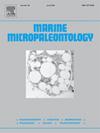Orbital-scale biotic and paleoceanographic changes in Japan Sea during the late Miocene global cooling (LMGC)
IF 1.5
4区 地球科学
Q2 PALEONTOLOGY
引用次数: 0
Abstract
The late Miocene global cooling (LMGC; ca. 7.9–5.8 Ma) was accompanied by global environmental changes including monsoon intensity, ocean circulation, and biotic turnover. Recent studies have revealed drastic environmental and biotic changes in the Japan Sea across the LMGC; the radiolarian fauna in the Japan Sea suggested decreased inflow of Pacific Central Water (PCW) species Tricolocapsa papillosa, increased subarctic species Cycladophora sphaeris and extinction of a dominant endemic radiolarian Cycladophora nakasekoi. These radiolarian fluxes showed ∼100-kyr eccentricity signals; however, the dominant paleoclimatic/paleoceanographic signal during the LMGC appeared to be ∼40-kyr obliquity cycle, which was not detected in the radiolarian fluxes possibly due to lower sampling resolution. Thus, orbital-scale variations of these radiolarian fluxes and their potential forcing mechanisms remain unclear.
In this study, we establish changes in the abundance of selected radiolarian species with a resolution that exceeds the 10-kyrs and suggest obliquity-paced changes in the paleoceanography in the Japan Sea during the LMGC. We detected ∼40-kyr cycles in abundance of T. papillosa, suggesting that PCW inflow into the Japan Sea was controlled by a 40-kyr obliquity-paced glacial cycle. We also detected a ∼ 40-kyr signal in C. sphaeris abundance, implying that the obliquity-paced winter monsoon probably promoted the inflow of subarctic water into the Japan Sea. Contrary, variation in C. nakasekoi abundance lacks a ∼ 40-kyr signal. A 100-kyr cycle is also observed in a summer monsoon proxy from lacustrine sediment in China. Hence, it is possible that C. nakasekoi decreased with weakened summer monsoon across the LMGC.
晚中新世全球变冷(LMGC)期间日本海生物和古海洋学的轨道尺度变化
晚中新世全球变冷;(约7.9-5.8 Ma)伴随着全球环境变化,包括季风强度、海洋环流和生物更替。最近的研究表明,日本海的环境和生物发生了剧烈的变化。日本海放射虫区系表明太平洋中部水(PCW)种三毛虫(Tricolocapsa papillosa)流入减少,亚北极种球形环虫(Cycladophora sphaeris)增加,特有优势放射虫中斑环虫(Cycladophora nakasekoi)灭绝。这些放射虫通量显示约100 kyr的偏心信号;然而,在LMGC期间,主要的古气候/古海洋信号似乎是~ 40-kyr的倾角旋回,这可能是由于采样分辨率较低而没有在放射虫通量中检测到。因此,这些放射虫通量的轨道尺度变化及其潜在的强迫机制仍不清楚。在这项研究中,我们以超过10年的分辨率建立了选定放射虫物种丰度的变化,并提出了在LMGC期间日本海古海洋学的斜向节奏变化。我们在大量的T. papillosa中检测到~ 40-kyr的旋回,这表明PCW流入日本海是由一个40-kyr的倾斜速度冰川旋回控制的。我们还在C. sphaeris丰度中检测到一个~ 40-kyr的信号,这意味着斜向冬季季风可能促进了亚北极水流入日本海。相反,C. nakasekoi丰度的变化缺乏~ 40-kyr信号。在中国湖泊沉积物的夏季风代用物中也观察到100 kyr的周期。因此,中色草有可能随着夏季风减弱而减少。
本文章由计算机程序翻译,如有差异,请以英文原文为准。
求助全文
约1分钟内获得全文
求助全文
来源期刊

Marine Micropaleontology
地学-古生物学
CiteScore
3.70
自引率
15.80%
发文量
62
审稿时长
26.7 weeks
期刊介绍:
Marine Micropaleontology is an international journal publishing original, innovative and significant scientific papers in all fields related to marine microfossils, including ecology and paleoecology, biology and paleobiology, paleoceanography and paleoclimatology, environmental monitoring, taphonomy, evolution and molecular phylogeny. The journal strongly encourages the publication of articles in which marine microfossils and/or their chemical composition are used to solve fundamental geological, environmental and biological problems. However, it does not publish purely stratigraphic or taxonomic papers. In Marine Micropaleontology, a special section is dedicated to short papers on new methods and protocols using marine microfossils. We solicit special issues on hot topics in marine micropaleontology and review articles on timely subjects.
 求助内容:
求助内容: 应助结果提醒方式:
应助结果提醒方式:


